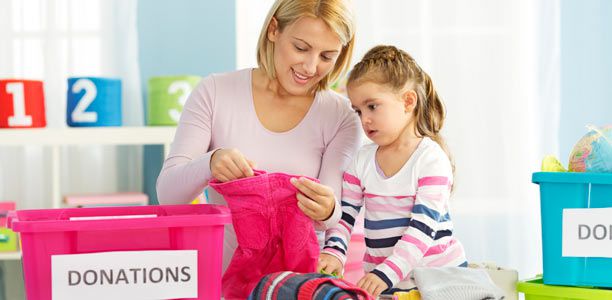We all want our children to have the best opportunities and facilities to help them grow, learn and play, but we also want them to grow up to be empathetic, compassionate adults who care for those less fortunate than themselves and share what they have. Although some schools teach children about the importance of giving to charity, parents play a crucial role in developing caring, sharing children who will grow into charitable adults.
Teaching children to give
Fortunately for parents, children are naturally inclined to have empathy for and be generous and helpful to those around them. So when it comes to developing pro-social behaviours like charitable giving, it’s not so much a matter of teaching kids as it is about giving them opportunities to develop and act on their naturally empathetic and generous instincts.
So what can parents do to encourage and develop the compassionate, charitable behaviours which seem to come naturally to kids? It’s important to be a role model so that your children learn from your example about the importance of giving to those less fortunate than themselves. However it’s also important to talk to your child and explain to them what you’re doing and why. Children are more likely to give to charity if their parents talk to them about it. This is true for boys and girls of all ages, regardless of other factors like the child’s race or income level.Be prepared for a complex discussion- you and your child won’t be able to give to every needy person in the world, so you’ll also need to help them make decisions about how and to whom they should give.
Consider what they already know about charitable giving. For example, what things do they already do to help other people? Do they know that you give to charity and which charities you support? Have you spoken to them about why you chose those charities? If not, think about how you can explain your own charitable behaviour to your children, in language that’s appropriate and understandable for their age. Focus on the emotional benefits of those you’ll help by giving to charity, rather than telling your child to give simply because it’s the right thing to do. For example talk about how helping a hungry person with food will contribute to their happiness and better life.
Ways of giving
 Talk to your children about the range of different ways they can give to those less fortunate than themselves. When we think about charitable giving, donating money to a cause often springs to mind. Some children may give a portion of their pocket money or wages to charity, or make a donation at a special time of year like Christmas. But there are plenty of ways children can give to those less fortunate without giving money. Why not try:
Talk to your children about the range of different ways they can give to those less fortunate than themselves. When we think about charitable giving, donating money to a cause often springs to mind. Some children may give a portion of their pocket money or wages to charity, or make a donation at a special time of year like Christmas. But there are plenty of ways children can give to those less fortunate without giving money. Why not try:
- Lending a hand in your neighbourhood- for example your child could help an elderly person mow the lawn or clean the yard (depending on what’s age appropriate) or they could help the young couple next door by playing or reading with their children.
- Using some school holidays to get involved in a community organisation. Voluntary work is a great way for children to learn about giving. While boys and girls are equally likely to give to charity, girls are more likely than boys to give by volunteering. Volunteering at a community based organisation may provide opportunities for your child to keep giving throughout the year.
- Donating blood with your child (aged 16 years and above) to help them understand the importance of helping others who are not as healthy as they are. Blood is a lifesaving resource that doesn’t cost a cent to give. While children under 16 are not eligible to give blood, this is an important way older adolescents can learn that some of the most important things in life are priceless.
- Encouraging your child to give clothes, books and toys that they have outgrown to a charity or another child less fortunate than themselves.
- Helping your child select a charity they would like to donate money to. Take time to discuss how other people will benefit from their donation, and their reasons for choosing the particular charity. Think about charities which help other children, as children might relate especially well to other children.
When to talk to your child about giving
It’s never too early to talk to your child about giving. Research shows even toddlers experience happiness when they give to others. By five years of age children have developed emotionally and are sensitive to the feelings of others around them. They should also enjoy both giving and receiving and understand sharing.
What children gain from giving
Children also gain from giving to charity, for example by:
- Behaving in a pro-social manner, that is making some type of sacrifice to ensure another person benefits like giving something that costs money or sacrificing time to help another person.
- Expressing emotions like empathy, caring and kindness. These are all examples of pro-social emotions which kids tend to have a natural inclination for at a young age. However there’s a lot of advertising that encourages kids to be self-interested, so it’s important to encourage and provide opportunities to practice these emotions.
- Increasing their understanding of the world around them and their place in it. For example, they will learn about the interdependence between people in different parts of the world and their relatively privileged position in it.
- Being happy- despite claims that people are primarily interested in helping themselves, research shows the opposite it true- adults, children and toddlers experience more joy when giving than they do when receiving.
- Developing problem solving skills when you involve them in making decisions, for example about which charity to give to and what to donate.
References
- Oesterreich L. Ages and Stages- Five years old. In L. Oesterreich, B. Holt, & S. Karas, Iowa family child care handbook [Pm 1541] (pp. 207-210). Ames, IA: Iowa State University Extension. (Reprint)
- Women Give 2013- New Research on Charitable Giving by Girls and Boys. Lilly Family School of Philanthropy. Indiana University. Women’s Philanthropy Institute. Available from: (URL Link)
- Aknin LB, Hamlin JK, Dunn EW. Giving leads to happiness in young children. PLOS One. 2012; 7: 6. Available from: (URL Link)
- Australian Red Cross Blood Service. Who can give blood. 2013. (cited 2 December 2013). Available from: (URL Link)
- Willis, C. Decision making- the foundation of responsible behaviour. University of Arizona. 1999. (cited 14 October 2013). Available from: (URL Link)



 (10 votes, average: 4.60 out of 5)
(10 votes, average: 4.60 out of 5) 






